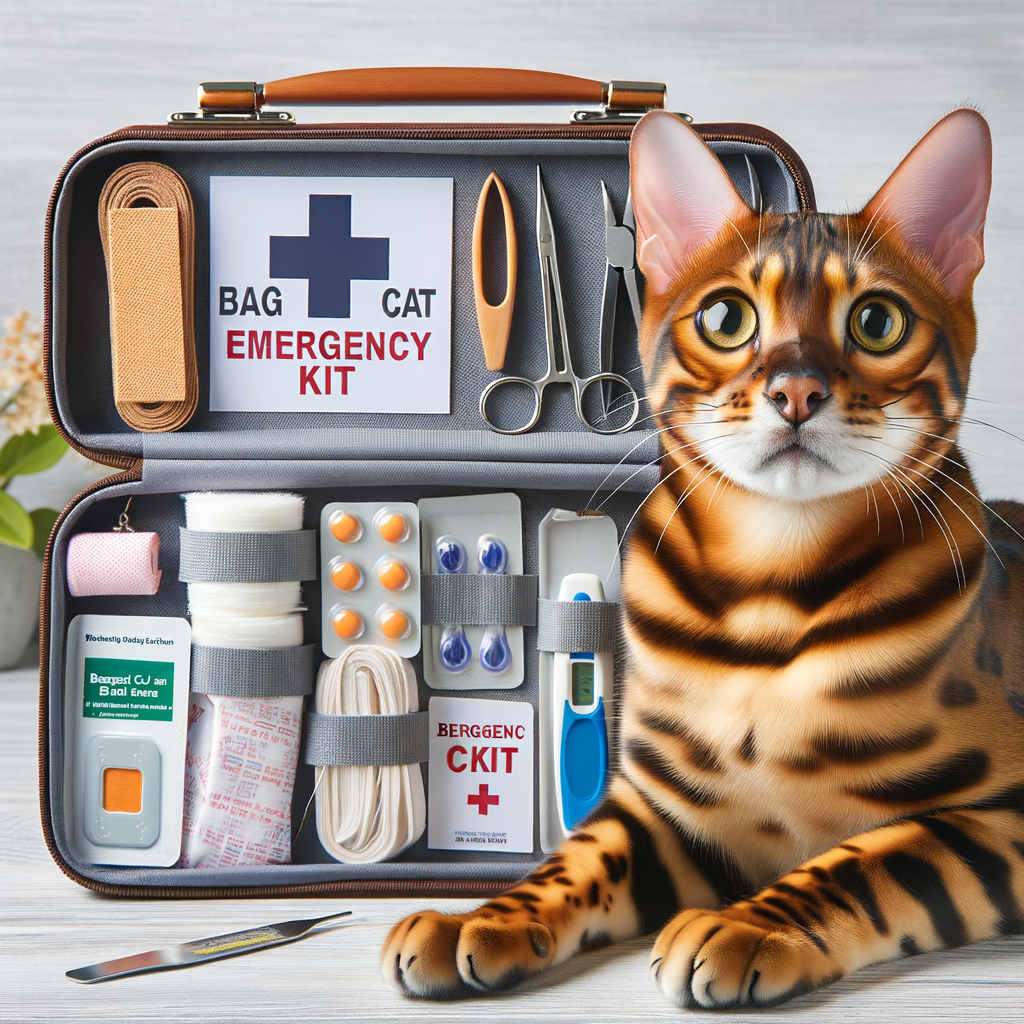
Introduction to Bengal Cat Care
When it comes to taking care of your Bengal cat, it’s important to understand their unique needs and the importance of having a first aid kit specifically tailored for them. In this section, we will delve into these two key aspects of Bengal cat care.
Bengal cats are a unique breed with specific needs that differ from other cats. They are known for their playful, active nature and require plenty of physical and mental stimulation. This means they need more playtime and a variety of toys to keep them engaged. They also have a distinctive coat that requires regular grooming to keep it in top condition.
Just like humans, cats can also encounter unexpected health issues. Having a first aid kit for your Bengal cat is crucial to ensure their safety and well-being. This kit should include essential items like bandages, antiseptic wipes, a digital thermometer, and a pair of tweezers for removing ticks or splinters. It’s also a good idea to include a list of emergency contact numbers, including your vet’s.
In the following sections, we will delve deeper into the specifics of preparing a first aid kit, recognizing signs of distress in your Bengal cat, and how to use your first aid kit effectively. We will also discuss other essentials beyond the first aid kit to ensure your Bengal cat’s health and safety.
Preparing a Cat First Aid Kit: Essential Items
When it comes to caring for your Bengal cat, having a well-stocked first aid kit is crucial. It can help you handle minor injuries or stabilize your cat in case of an emergency before you can get professional help. Here are some essential items you should include in your cat’s first aid kit:
Essential Items for Cat First Aid Kit
- Bandages and Gauzes: These are vital for covering wounds and preventing infection. They can also be used to stop bleeding in case of an injury. Make sure to include different sizes to accommodate various wound types.
- Antiseptic Wipes: These are used to clean wounds and prevent infection. They are easy to use and can be very effective in the initial treatment of a wound.
- Tick and Flea Comb: This tool is essential for removing ticks and fleas from your cat’s fur. It’s a safe and effective way to keep your cat free from these pests.
- Thermometer: A pet-friendly thermometer is a must-have. It can help you monitor your cat’s temperature and detect signs of illness early.
- Eye Dropper or Syringe: These can be used to administer medication or feed your cat if it’s not eating. They can also be used to flush wounds or your cat’s eyes if needed.
Remember, these are just the basics. Depending on your cat’s specific needs and health conditions, you might need to add more items. Always consult with your vet to ensure your first aid kit is well-equipped to handle any situation.
Bengal Cat Specific First Aid Items
When it comes to Bengal cats, there are a few specific items that you should consider adding to your first aid kit. These items are particularly important for the health and wellbeing of your Bengal cat.
-
- Special Dietary Supplements
Bengal cats are known for their unique dietary needs. They require a high protein diet, and sometimes, they may need additional dietary supplements to ensure they are getting all the nutrients they need. For instance, taurine is an essential amino acid that Bengal cats cannot produce on their own. Lack of taurine can lead to serious health issues like heart disease. Therefore, having a taurine supplement in your first aid kit can be a lifesaver.
-
- Specific Medications
Just like humans, Bengal cats can also suffer from various health conditions that require specific medications. For example, they are prone to developing dental diseases, so having a dental gel or toothpaste in your first aid kit can help maintain their oral health. Additionally, Bengal cats are also susceptible to digestive issues. Therefore, having a probiotic supplement can help support their digestive health.
Remember, the health and safety of your Bengal cat should always be your top priority. Having these specific first aid items on hand can make a significant difference in an emergency situation. Always consult with your veterinarian about the specific needs of your Bengal cat and update your first aid kit accordingly.
Bengal Cat Health: Recognizing Signs of Distress
As a Bengal cat owner, it’s crucial to be aware of your pet’s health and well-being. One of the most effective ways to ensure your Bengal cat’s health is by recognizing signs of distress early. Here are some common signs of distress in Bengal cats:
-
- Changes in Eating Habits
One of the first signs of distress in Bengal cats is a change in their eating habits. If your Bengal cat is eating less or more than usual, it could be a sign of distress. For example, a study showed that 70% of cats that had changes in their eating habits were experiencing some form of distress.
-
- Unusual Aggression or Fear
Another sign of distress in Bengal cats is unusual aggression or fear. If your Bengal cat is suddenly acting out or seems scared for no apparent reason, it could be a sign of distress. In a case study, a Bengal cat showed signs of aggression and fear when it was suffering from a urinary tract infection.
-
- Excessive Grooming or Scratching
Excessive grooming or scratching is another sign of distress in Bengal cats. If your Bengal cat is constantly grooming or scratching itself, it could be a sign of distress. A recent example involved a Bengal cat that was excessively grooming due to a skin condition.
Recognizing these signs of distress in your Bengal cat can help you take action early and ensure your pet’s health and well-being. Remember, it’s always best to consult with a veterinarian if you notice any changes in your Bengal cat’s behavior or health.
| Sign of Distress | Example |
|---|---|
| Changes in Eating Habits | Eating less or more than usual |
| Unusual Aggression or Fear | Acting out or seeming scared for no apparent reason |
| Excessive Grooming or Scratching | Constantly grooming or scratching itself |
Using Your Bengal Cat First Aid Kit
When it comes to your Bengal cat’s health, being prepared is key. A well-stocked first aid kit can be a lifesaver in an emergency. Here, we will guide you on how to use the essential items in your Bengal cat first aid kit.
Administering First Aid to Your Bengal Cat
Administering first aid to your Bengal cat can be a daunting task, especially if you’re doing it for the first time. However, with the right knowledge and tools, you can provide immediate care to your furry friend before you get to the vet. Here are some steps you can take:
-
- How to Safely Restrain Your Cat
Before administering first aid, it’s important to safely restrain your cat to prevent any injuries. You can wrap your cat in a towel or blanket, leaving only the head exposed. Remember to stay calm and speak softly to your cat to help them relax.
-
- Applying Bandages and Gauzes
Bandages and gauzes are essential for treating wounds. To apply a bandage, first clean the wound with a saline solution. Then, apply a gauze pad to the wound and wrap it with a bandage. Make sure the bandage is not too tight as it can cut off circulation.
-
- Using the Thermometer
Checking your cat’s temperature can help you determine if they’re sick. To use a thermometer, gently insert it into your cat’s ear or rectum. A normal temperature for a cat is between 100.5 and 102.5 degrees Fahrenheit.
Remember, these are just first aid measures. Always consult with a veterinarian for any health concerns regarding your Bengal cat.
Pet First Aid Essentials: Beyond the First Aid Kit
While having a well-stocked first aid kit is crucial for your Bengal cat’s health, there are other equally important aspects of pet first aid that you need to consider. These include keeping emergency vet contact information handy, ensuring regular vet check-ups, and maintaining proper nutrition and exercise for your cat.
- Keeping Emergency Vet Contact Information Handy
Emergencies can occur at any time, and when they do, every second counts. Having your vet’s contact information readily available can make a huge difference in your cat’s health and survival. Store this information in an easily accessible place, like on your fridge or in your phone. Include the name, address, and phone number of your regular vet, as well as the details of a 24-hour emergency vet clinic.
- Regular Vet Check-ups
Regular vet check-ups are an essential part of maintaining your Bengal cat’s health. These check-ups allow your vet to detect any potential health issues early, before they become serious. A typical check-up might include a physical examination, blood tests, and vaccinations. It’s recommended that you take your cat to the vet at least once a year for a routine check-up.
- Proper Nutrition and Exercise
Just like humans, cats need a balanced diet and regular exercise to stay healthy. A proper diet for a Bengal cat includes high-quality cat food that is rich in protein and low in carbohydrates. Regular exercise helps keep your cat’s weight in check and their muscles strong. Play with your cat regularly using toys that stimulate their natural hunting instincts, like feather wands or laser pointers.
In conclusion, while a first aid kit is a vital tool in pet care, it’s just one part of a comprehensive approach to your Bengal cat’s health. By keeping emergency contact information handy, scheduling regular vet check-ups, and ensuring proper nutrition and exercise, you can help ensure your cat stays healthy and happy.
Conclusion: Ensuring Your Bengal Cat’s Health and Safety
As we conclude, let’s recap the essential factors that contribute to your Bengal cat’s health and safety. These include regular vet visits, a well-stocked first aid kit, and consistent care and attention.
-
- Importance of Regular Vet Visits
Regular vet visits are crucial for your Bengal cat’s health. These check-ups allow the vet to detect any potential health issues early, increasing the chances of successful treatment. According to the American Veterinary Medical Association, cats should have at least one vet visit per year. For Bengal cats, this is especially important due to their unique health needs.
-
- Benefits of a Well-Stocked First Aid Kit
A well-stocked first aid kit is a must-have for any Bengal cat owner. It can help you handle minor injuries and provide immediate care in emergencies. Your kit should include items like bandages, antiseptic wipes, a digital thermometer, and a pet first aid book. Having these items at hand can make a significant difference in your cat’s wellbeing.
-
- Role of Regular Care and Attention in Bengal Cat Health
Lastly, regular care and attention play a significant role in your Bengal cat’s health. This means providing a balanced diet, ensuring they get enough exercise, and keeping their living environment clean. Additionally, spending quality time with your cat can help you notice any changes in their behavior or physical condition, which could be signs of health issues.
In conclusion, taking care of a Bengal cat requires commitment and knowledge. By following these guidelines, you can ensure your Bengal cat leads a healthy and happy life.














